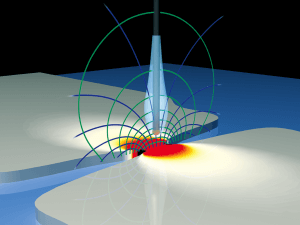Summary
Through its phenomenal ability to image soft tissues, magnetic resonance imaging (MRI) has revolutionized both clinical medicine and research biomedicine. Nowadays, MRI scanners used clinically have spatial resolutions in the range of 0.5 mm. This enables identification and monitoring of disease processes throughout the body and visualization of minute brain structures. Magnetic resonance microscopy (MRM) brings the resolution down to the micron scale, so that cells and parts of cells can be seen. Using ultrasensitive silicon nano-wired mechanical resonators, we are working to distinguish small ensembles of nuclear and electron spins. In doing so, we are striving to bring MR down to the nanometer scale, allowing imaging of single viral particles. Subsequently, extending the approach to the Angstrom scale, our goal is to demonstrate MR imaging of individual protein molecules.

Related Content

Photonic Quantum Processor
Photonic quantum processors based on integrated quantum photonic circuits require entangled photon pairs to perform quantum computations. However, current state-of-the-art technologies utilize probabilistic entangled photon sources with limited pair-extraction efficiencies, negatively affecting the computation speed. This project aims to boost the speed of on-chip quantum operations by using bright, on-demand entangled photon sources with an […]
April 24, 2023

Quantum Simulations of Fundamental Interactions
Summary To address questions in modern physics such as “what is the structure of matter inside neutron stars?” we need better computational methods to evaluate the interplay of fundamental forces between elementary particles. To-date the response to such questions rests on numerical computer simulations that are inherently limited. In this project, we develop new theoretical […]
April 18, 2019

Tuning Spin-Exchange Interactions in Low-Dimensional Metal Halide Perovskites: A New Class of Semiconductor Quantum Materials
Summary Leakage current in electronic components is one of the limiting factors for the performance of conventional computers which use charges and currents as physical information carriers. Spintronics offers an alternative by using electron spin for information transfer, processing and storage, enabling the design of non-volatile computer memory and more energy-efficient electronic devices. In this […]
October 1, 2019

Scanning Tunneling Microscopy of Quantum Materials, Devices and Molecules
Summary This project advances our ability to characterize and study novel quantum materials, quantum devices, and even individual molecules at the atomic level. By combining Non-Contact Atomic Force Microscopy (NC-AFM), Scanning Tunneling Microscopy (STM) and scanning gate methods, we correlate spatial information with transport properties and can locally manipulate charge, spin and structural states. […]
January 28, 2019

